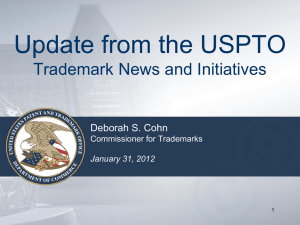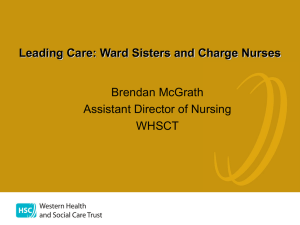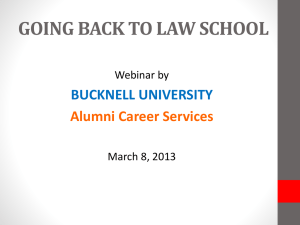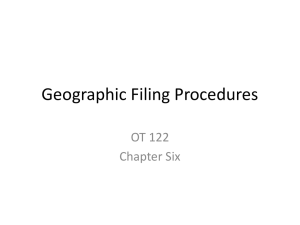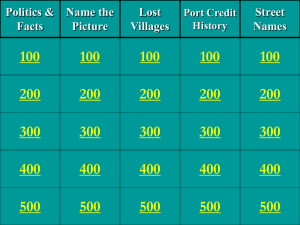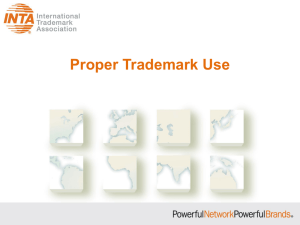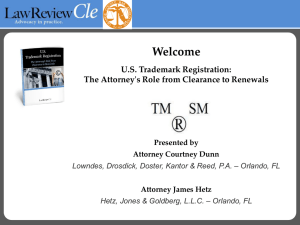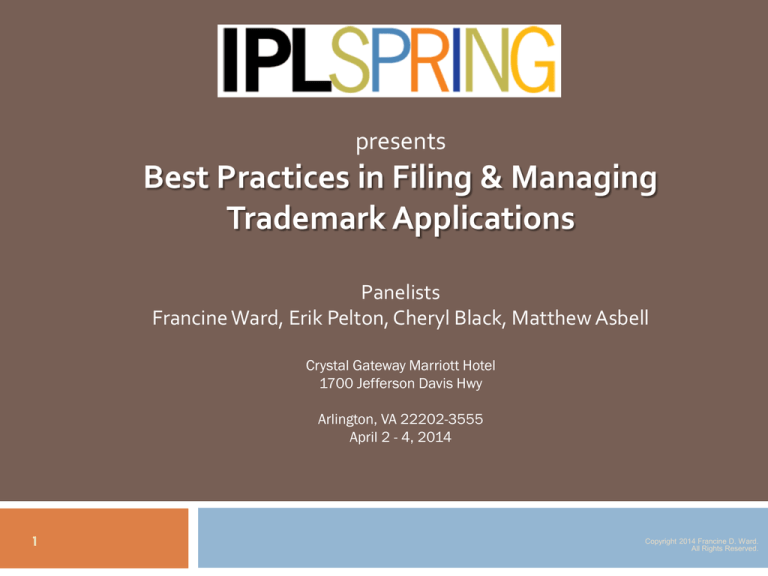
presents
Best Practices in Filing & Managing
Trademark Applications
Panelists
Francine Ward, Erik Pelton, Cheryl Black, Matthew Asbell
Crystal Gateway Marriott Hotel
1700 Jefferson Davis Hwy
Arlington, VA 22202-3555
April 2 - 4, 2014
1
Copyright 2014 Francine D. Ward.
All Rights Reserved.
About Francine D. Ward
2
Francine Ward is a business and intellectual property attorney, with a focus on copyrights,
trademarks, publishing, entertainment, and social media legal issues. A 1989 graduate of
Georgetown University Law Center, Francine is admitted to practice in New York (1991),
California (2007), and the District of Columbia (2013). Additionally, she is admitted to the Bar
of the U.S. Circuit Courts of Appeals for the 2nd and 9th Circuits; as well as the U.S. District
Courts for the Central District of California and the Southern District of New York. Ward is
Chair of the ABA-IPL USPTO Trademark Affairs EX-Parte Committee, Chair of the ABA-IPL
Terms of Use Subcommittee of the Copyright & Social Media Committee, and an Officer of
the Copyright Interest Group of the California State Bar.
Feel free to visit Francine’s website (http://francineward.com/attorney/), Blog
(http://francineward.com/category/legal-blog/), LinkedIn Profile
(http://www.linkedin.com/in/trademarklawyer), Facebook Law Fan Page
(https://www.facebook.com/Francineward), and her Twitter Law Page
(https://twitter.com/Francineward).
Copyright 2014 Francine D. Ward.
All Rights Reserved.
About Erik Pelton
3
Erik Pelton is the founder of Erik M. Pelton & Associates,
PLLC® a boutique trademark law firm in Falls Church Virginia,
and a former trademark examiner at the USPTO. Erik counsels
clients regarding trademark registration and disputes, and has
registered approximately 2,000 trademarks with the USPTO. In
2010, Erik created an iPhone application for intellectual
property practitioners called Apptorney®. A graduate of
Catholic University School of Law and Boston University, Erik
has also represented parties in dozens of proceedings before
the Trademark Trial and Appeal Board.
Copyright 2014 Francine D. Ward.
All Rights Reserved.
About Cheryl Black
4
Cheryl Black currently serves as in-house counsel for Evergreen
Enterprises and has more than 20 years of experience as an intellectual
property attorney, including her career at the United States Patent and
Trademark Office (USPTO) and as a partner at the law firm of Goodman
Allen & Filetti. Ms. Black previously served on the USPTO Trademark Public
Advisory Committee and is currently a member of the ABA-IPL
Landslide Magazine Editorial Board, a member of the Board of Governors
and chair of the Law Practice Management Division of the Virginia Bar
Association, and on the faculty for the Virginia State Bar Professionalism
Course. Ms. Black earned her J.D. from Georgetown University Law Center
and is admitted to practice in the District of Columbia and Virginia, as well
as the U.S. District Court for the Eastern District of Virginia.
Copyright 2014 Francine D. Ward.
All Rights Reserved.
About Matthew D. Asbell
5
Matthew D. Asbell is a newly minted partner in the New York office of the international
intellectual property boutique firm of Ladas & Parry LLP. Mr. Asbell has worked extensively in
matters involving the use and registration of trademarks around the globe.
Mr. Asbell has served in numerous leadership roles in local and national bar associations. He
was a Young Lawyer Fellow of ABA Section of Intellectual Property Law. He has authored, coauthored, and edited publications on the topics of trademark, licensing, copyright, patent,
broadcasting and internet and privacy law. In association with his colleagues, Mr. Asbell
released a two-book series on Intellectual Property for the 21st Century Corporation through
John Wiley & Sons. He received his B.S. in Psychology from Carnegie Mellon University and
attended the Medical College of Pennsylvania and Hahnemann University School of
Medicine. He received his J.D. from the Benjamin N. Cardozo School of Law, where he was
president of the Intellectual Property Law Society and Acquisitions Editor of the top-ranked
Cardozo Arts and Entertainment Law Journal. Mr. Asbell is registered to practice as a patent
attorney before the U.S.P.T.O. and is admitted to the bars of New York and New Jersey.
Copyright 2014 Francine D. Ward.
All Rights Reserved.
What is a Trademark?
A distinctive word,
name, phrase, design,
logo, or combination
thereof, which identifies
the source of a product
or service.
A Source identifier.
Copyright 2014 Francine D. Ward.
6
All Rights Reserved.
AGENDA (Best Practices)
7
1.
2.
3.
4.
Selection & Clearance
Filing
Managing
International Trademark Issues
Copyright 2014 Francine D. Ward.
All Rights Reserved.
8
Selection and Due Diligence
Copyright 2014 Francine D. Ward.
All Rights Reserved.
MOST Important Step in the Process …
Choosing a
Mark that
can be
protected
Copyright 2014 Francine D. Ward.
9
All Rights Reserved.
The More DISTINCTIVE …
10
Fanciful / Coined
Arbitrary
Suggestive
Copyright 2014 Francine D. Ward.
All Rights Reserved.
2nd MOST Important Step …
Copyright 2014 Francine D. Ward.
11 Reserved.
All Rights
When to do Due Diligence
1.
2.
3.
4.
5.
6.
7.
Starting a business
Building a brand
Acquiring a business
Purchasing Assets
Purchasing a Franchise
Licensing a trademark
Collaborating with someone with a
brand
Copyright 2014 Francine D. Ward.
12 Reserved.
All Rights
Knock-out Search
Limited screening designed to
identify & eliminate trademarks
that clearly cannot be registered:
1.
2.
3.
Generic. (TMEP 1209.01 (c)).
Scandalous (§2(a)).
Obviously Famous.
Copyright 2014 Francine D. Ward.
13 Reserved.
All Rights
Comprehensive Search
Full screening that looks
in every possible venue to
determine if a trademark
can likely be cleared
Copyright 2014 Francine D. Ward.
14 Reserved.
All Rights
What to LOOK for
1.
2.
3.
4.
5.
Prior rights holders
Existence of Identical or Similar marks
Potential risks/challenges e.g., Office
Actions, Oppositions, Cancellations
True owner of record, assignments
Issuance of demand letters
Copyright 2014 Francine D. Ward.
15 Reserved.
All Rights
Where to Search
USPTO Trademark Electronic Search
System (TESS)
All 50 States
(http://www.uspto.gov/trademarks/process/State_Trademark_Links.jsp)
Online search engines e.g., Google, Bing
Dun & Bradstreet business directory
Domain Name Database
Foreign Registration Database
Copyright 2014 Francine D. Ward.
16 Reserved.
All Rights
Who Performs the Search?
1.
2.
3.
Client
Search Company *
Lawyer
* CAVEAT: They only do the search,
they do NOT analyze the report.
Copyright 2014 Francine D. Ward.
17 Reserved.
All Rights
Best Practices
1.
2.
3.
Counsel Client to:
Take extra care in selecting a mark;
Be clear as to how the mark will look;
Perform a Comprehensive Search, and
Inform Client that a Search is not 100%;
Get ALL instruction in writing.
Copyright 2014 Francine D. Ward.
18 Reserved.
All Rights
19
Filing Trademark Applications
Copyright 2014 Francine D. Ward.
All Rights Reserved.
Trademark Prosecution Tips
Presented by Erik M. Pelton
ABA-IPL Conference – Spring 2014
®
The Nontraditional Trademark Lawyers
© 2014 Erik M. Pelton & Associates, PLLC. All Rights Reserved.
Filing Basis
• Intent to use (ITU) – Section 1(b)
• Use in commerce – Section 1(a)
• Foreign Filing bases
Filing Basis
• Intent to use (ITU) – Section 1(b)
• Bona Fide Intent = objective determination based on all the
circumstances. Swatch AG (Swatch SA ) (Swatch Ltd.) v. M.Z.
Berger & Co., Inc., Opposition No. 91187092 (TTAB Sept. 30,
2013).
• Generally proof of intent is evidenced by some documentary
evidence regarding ongoing plans for making use the mark
• After receiving Notice of Allowance, Applicant will have to follow
up with a Statement of Use to complete registration process
• Initial follow-up period is 6 months, but you can receive up to
5 extensions for a total period of 3 years.
Filing Basis
•
Use in commerce – Section 1(a)
• Use = in the ordinary course of trade, and not merely
to reserve a right in the mark
• i.e. with goods, this means bearing the mark AND
sold or transported, even if the products are
seasonal or infrequently purchased. Clorox Co. v.
Hermilo Tamez Salazar, Opposition No. 91198922
(TTAB Sept. 26, 2013).
Filing Basis
• Foreign Filing bases
• Section 44(d) file within six months of filing
a foreign application
• Section 44(e) based off foreign registration;
no need to show use in U.S. to get initial
registration, but you WILL have to eventually
show use
• Must have bona fide intent to use in US
The Mark / Drawing
Name vs. Logo
• When wording alone is registered, Registrant can use ®
whenever the words are used—in text, logos, and more.
Protection covers all fonts, styles, colors. When a design is
registered, protection is technically limited to the exact design
itself
• Designs are more likely to change over time
• This doesn’t mean that you shouldn’t protect your logos, but you
should generally do so in a separate application
• Logos: Black & White vs. Color
• Black and white covers all color possibilities
• Might want to file two versions of logo
Nontraditional Trademarks
•
Pay particular attention to:
•
Drawing of the mark
•
Description of the mark
•
Specimen of use
•
Possible evidence of acquired distinctiveness
•
“look for” advertising
•
Can now upload sound and video files to USPTO
Description (“I.D.”) of Goods/Services
Balance = broad vs. accurate
Include keywords that competitors may use in searching the register
Possibly craft ID to try to avoid a 2(d) refusal
Cannot use registered trademarks in ID descriptions
TEAS+
• Cheaper to File ($50 less), but stricter requirements
• Must choose ID for G&S directly from the acceptable G&S ID
manual, meaning you have limited opportunities to customize the
G&S ID
• Good for straightforward applications in definite fields
• ID Manual
• Available on the USTO website and searchable online
(http://tess2.uspto.gov/netahtml/tidm.html)
• Can email suggestions to USPTO at tmidsuggest@uspto.gov
•
•
•
•
•
Proper Signature on Application
• Proper Signatory
• Generally, Attorney should NOT sign the application or declarations
regarding use of the mark, dates of use, validity of specimens, and/or
distinctiveness of a mark
• Generally fine for Attorney to sign other basic filings (i.e. Response to
Office Action) if they don’t include declaration
• Tips for Online Filing/Signature Email
• Include the name of the mark near your name (in the Attorney
signature block) so you can keep track of the USPTO emails
• Include your phone number for BOTH signature blocks so the client
isn’t sent USPTO correspondence he/she might not understand
• Have email sent to you first, then you send it to client so you know if it
bounces
General Online Filing Tips
• USPTO.gov is a tremendous resource featuring databases,
electronic forms, news, and other information relevant to
the trademark registration process
• Trademark Manual of Examining Procedure (TMEP)
• Ability to suggest changes/updates or make comments to the
USPTO re: TMEP using IdeaScale
• File all forms electronically
• System updates and downtimes
• Official Gazette
• Create PDF files of up to 25 registration certificates at once
• See written materials for much more
30
Managing Trademark Applications
Managing a Trademark Application
for ABA-IPL Spring
Conference 2014
Cheryl L Black
Counsel - IP and Innovation
31
Examination Stage
1.
2.
3.
An Examining Attorney at the USPTO reviews the application and may
issue an Office Action if the application requirements are not met or
if there is a basis for refusing registration.
Procedural Requirements - Common Informalities
Identification of Goods
Disclaimer
Description of the Mark
Specimen
Statutory Requirements - Substantive Refusals
2(d) Refusal - Likelihood of Confusion
2(e) Refusal - Merely Descriptive
Examination Stage
1.
2.
Responding to Office Actions
Six-month response period
All Issues must be resolved
Examiner’s Amendment or Priority Action for Informalities
Formal Response for Substantive Refusals
Tips for Responding to Common Procedural Requirements
3.
Identification of Goods - Amendments to limit or clarify only. In re Swen Sonic Corp., 21
USPQ2d 1794 (TTAB 1991)
Tips for Responding to Common Substantive Refusals
2(d) Refusal - Likelihood of Confusion - In re E. I. du Pont de Nemours & Co., 476 F.2d
1357, 177 USPQ 563 (C.C.P.A. 1973) - 13 du Pont factors
2(e) Refusal - Merely Descriptive - 2(f) Acquired Distinctiveness or Supplemental Register
Examination Stage
1.
2.
3.
If all requirements are met and any refusals are overcome or no issues found in initial
review, the Examining Attorney will approve the mark for publication. The application
proceeds to the opposition stage.
If all requirements are not met and any refusals are not overcome, the examining attorney
may issue subsequent Office Actions to maintain or make final the outstanding issues.
If a Final Office Action issues, the applicant may file a notice of appeal of the final decision
with the Trademark Trial and Appeal Board (TTAB).
Caution about response to Final Office Action
Request for Reconsideration
Incomplete Responses
TTAB Affirmance rate (TTABlog.com)
2(e)(1) refusals: 85.1% in 2013; 82% in 2012
2(d) refusals: 84.1% in 2013; 90% in 2012
Publication Stage
1.
2.
The mark is published in the USPTO’s Official Gazette for thirty days.
The publication is available for public review and any third party who
can prove they will be injured by the registration of a mark may file an
opposition with the TTAB.
Official Gazette is available electronically on USPTO website. New
searchable web-based format released last year
Third party has 30 days from date of publication to file notice of
opposition or request extension of time to file a notice of
opposition.
If no opposition is filed or applicant prevails in the opposition, the
application proceeds to the post-publication stage.
Post-Publication Stage
1.
2.
If the application is based on 1(a), 44 or 66(a), a statement of use is not
required. After the opposition stage, the application proceeds to registration and
a certificate of registration is issued.
If the application is based 1(b) on “intent to use,” it proceeds to registration only
after an acceptable statement of use is filed. The Office will issue a Notice of
Allowance after publication stage. Applicant has six months to file a statement
of use or request extension of time to file a statement of use.
3.
Statement of Use requires dates of first use and specimen
Extension Request granted for six-month periods. Up to five extension requests may be
filed
Practice Tip: Insurance Extension Request
Statement of Use are examined by the Examining Attorney. It is possible to
receive Office Action after review of statement of use.
Registration and Beyond
1.
2.
The term of a registration is ten years and may be renewed every ten
years.
In order to maintain the registration for the entire 10-year term, the
registrant must
3.
4.
Continue use of the mark in commerce
File a declaration of continued use between the fifth and
sixth year after registration
Every 10th anniversary, registrant must file a declaration of continue
use and renewal application to renew the registration
Registrants meeting certain statutory requirements are eligible to file a
claim of incontestability after the mark has been registered for five
years.
Practice Tips
1.
Docketing and Monitoring Application
2.
Reviving Abandoned Application
3.
Communications with Examining Attorney
4.
USPTO Resources:
ID Manual
Trademark Manual of Examining Procedure
1.
700: Examination Procedures
2.
900: Use in Commerce
3.
1100: Intent-to-Use Applications
4.
1200: Substantive Refusals
1.
Trademark Database (TESS and TSDR)
2.
TTAB Decisions
39
International Trademark Issues

